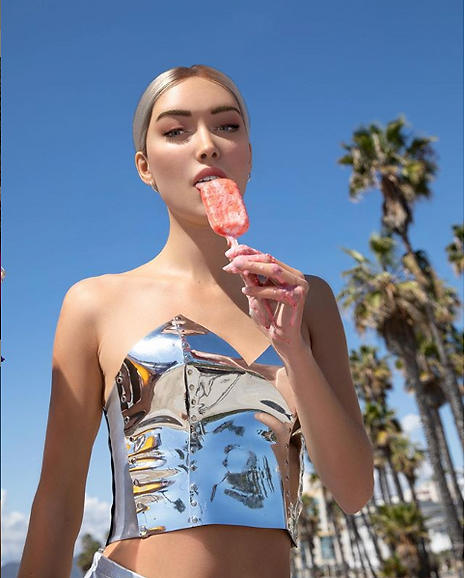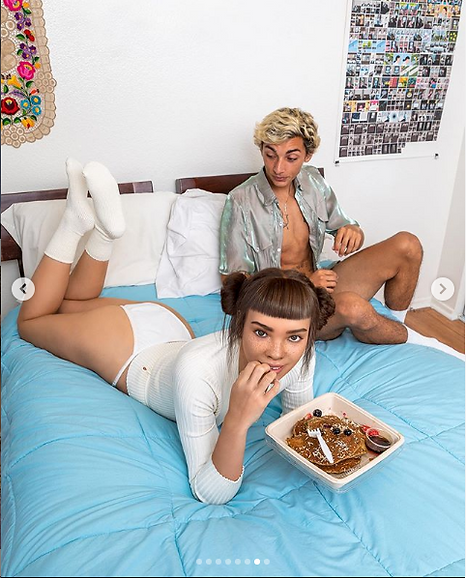About the Author

This website represents the culmination of my time at the University of Texas at Austin receiving my Masters in Media Studies.
I first began to take an interest in machine-human interactions and relationships in Dr. Sharon Strover's "Communication, Technology, and Culture" class, where I was first introduced to the digital influencer Lil Miquela. Miquela was the start of my thinking about the ways that we integrate machines and technology into our daily lives. In following this line of enquiry, I found myself contemplating the way that in taking a recuperative stance toward technology, and in looking at our images of machines and tech through a queer lens, can reveal new modes of being in the world. I found myself transfixed by the ways that these creations are frequently the backdrop that allow humans a way to imagine a different world and a different self. More often than not, these imaginings take on a distinctly counter-hegemonic sensibility.
Halfway through “Communication, Technology, and Culture” (Spring 2020), the COVID-19 pandemic forced us into remote online courses. I’m writing this section on the one-year anniversary of the World Health Organization declaring a worldwide pandemic. Since then, I’ve completed the majority of my Masters remotely.
Meet Lil Miquela's Squad
Building Believability Through Relationships
Further strengthening the connection between digital and real, Brud added two more digital characters to their repertoire in 2016 and 2018. The appearance of these two new characters came with their own backgrounds and personalities. Bermuda, a politically conservative blonde woman, and Blawko, a brand-oriented POC man who always has his mouth covered, came onto Miquela’s scene with their own intercrossing narratives.
While the manufactured narratives of these digital creations can seem trite, it’s relevant to understand that Bermuda and Blawko serve to strengthen Miquela’s public image and narrative, as well as give her simulated life more depth. This translates into higher engagement from users on Instagram, and further substantiates Brud within the population of brands using the social networking site. As Instagram has the highest engagement rate of any social networking site, delivering “58 times more engagement per follower than Facebook, and 120 times more engagement per follower than Twitter,” crafting personalities that hook users (and keep them coming back) is imperative to Brud’s ability to monetize Lil Miquela and her story.
Expanding Influence
If Brud is able to keep a host of characters within their repertoire they can drive engagement back to Miquela through a number of accounts. This urge to drive engagement is evident through the amount of photos Miquela is in with Blawko or Bermuda (or Nick while she was dating him. They’ve since “broken up” and the model has erased every photo on his Insta feed and started over). If Miquela isn’t in a photo chances are that her or a different Brud character has commented on it.
It is through this linking that Miquela expands her social influence. As Herbert Kelman theorized in his article, “Processes of Opinion Change,” social influence progresses through processes of compliance, identification, and internalization (62). He views these three processes as different means to link the individual and the social system (Kelman, “Further Thoughts," 126). While he originally conceived of this in terms of whenever a “person changes his behavior as a result of induction by another person or group,” the theory is still relevant in reference to social media accounts and influencers (128).
Below I’ve connected Kelman’s (1974) descriptions of compliance, identification, and internalization to the way that Lil Miquela operates on Instagram.

Compliance: when an individual accepts influence from another person or from a group to gain a specific reward from the other. This concept must be slightly adapted for Instagram as it is possible to follow a user and not interact or receive any awards from them. However, it could be argued that those that do interact with Miquela or other accounts on Instagram (in posting comments or sending private messages) do so in the hopes that there is a response.
Miquela prompts compliance in her “ability to supply or withhold material or psychological resources on which followers’ goal achievement depends” (Tafessee and Wood, 2). This can be directly seen when she teases a new romantic interest or a new song.
Identification: when a follower accepts the influencer and adopts their behavior. This establishes a self-defining relationship. This type of influence is based on attractiveness as “the influencer possesses qualities, such as desired roles, popularity, or creativity that the followers themselves lack” (Tafessee and Wood 2)
Miquela is representative of many of the elements of success. She jetsets around the world in designer clothing, booking modeling gigs and making music. She is liked by all who she interacts with.
Internalization: The user accepts influence because the behavior aligns with their value system. This can mean changing or adopting new behavior as a result of following the influencer (Tafessee and Wood, 3).
Adopting Miquela’s value system (3) could manifest in a number of ways. For example, users could align with her support of the Black Lives Matter movement, choose to download her music, or buy clothes that she has worn. Spanning the spectrum from social justice to capitalism, these would all be an example of internalization.
Social influence theory, while conceived of over 50 years ago, can be adapted and mapped onto social media today. While Miquela’s influence parallels the theory nicely, the inclusion of other characters within her narrative serves to strengthen her influence amongst three key constituencies:
1. Her own personal circle
2. Her followers
3. The larger network of Instagram
Miquela's Friends
Bermuda
Bermuda, a white blonde woman who used to support Trump and Tomi Lahren was created by Cain Intelligence (a fictional company also created by Brud).
She first arrives to Instagram in December 2016. She first arrived to Instagram in December 2016. Within a year (around August 2017) she begins to harass Miquela. The antagonism between her and Miquela grows as Bermuda’s captions grow more threatening. In April of 2018, Bermuda breaks the news to Miquela that she is not human. Since this revelation, Bermuda and Miquela have made amends and now act as each others’ confidants. In a brilliant marketing ploy, Bermuda, created by Brud, acted, not only as a direct foil for Lil Miqulea, but the vessel by which her true nature could be made public.
Brud not only utilizes its characters to lend depth and drama to Miquela’s narrative, but to progress it.
Blawko

Nick was Miquela’s boyfriend for a number of months. While this isn’t the first time we’ve seen her with a romantic interest, this was the first time it was explicitly stated that they were dating. They date for a few months, Nick appearing on Miquela’s feed in nine posts during that time. Upon coming back from Paris Fashion Week, Miquela announces their “Conscious Uncoupling.” Citing a need for growth and realizations, Miquela ends with the assurance that her and Nick are still incredibly close.
Who is Nick? Is he human?
Yes. He is human. Nick (last name unknown) is a model with New York Model Management and Demant St. Claire. While it might not have “worked out” with Nick and Miquela, the inclusion of a human into Miquela’s intimate circle connects back to my proposal of imagining a world where robots and humans mundanely (co)exist. As Donna Haraway states in “A Cyborg Manifesto,” not only is social reality lived social relations but that “the boundary between science fiction and social reality is an optical illusion” (149). Miquela and Nick’s relationship—while fictitious—inspires us to think about a reality where the line between human and machine is collapsed or, better yet, permeable to the extent where it is nonexistent.

With his first photo appearing January 18, 2018, Blawko is markedly different from Miquela. With his rambling Instagram captions, and photos that feature him partying, smoking, or showing off his latest outfit, Blawko (while still repping designer clothing) appears to be a lot less oriented towards sponsorships and monetization. Instead, I propose that, in being Miquela’s friend, he acts as a character to bolster her public image and give her simulated life more depth. He also creates public engagement on the platform through the networking/connecting of his account with Miquela’s.
Nick

Nick and "Speak Up"
Within two days of the breakup post, Miquela teases a new song. Two days after that, she announces this new song, “Speak Up.” Nick’s blurred out face is on the cover. The song drops on March 11, 2020 with the subsequent video dropping March 24. Nick is heavily featured in both the music video, and the posts leading up to it. Miquela hyped the music video as a video with her “real life ex turned BFF/brother and all his abdominal muscles while we reenact our failed relationship”.
For my full analysis for the "Speak Up" music video click here.




